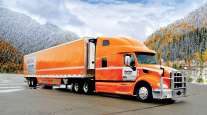Have Trucking Insurance Premiums Peaked?

[Stay on top of transportation news: Get TTNews in your inbox.]
With the year more than halfway completed, there has been much concern about rising insurance premium costs. However, are we getting close to an environment in which those rates are leveling out or even reversing course? And what are the main factors to get the industry there? Here’s what insurance experts are saying:
Leveling Off
Industry experts say that although there is evidence of premiums ebbing, there is still reason for caution:
- “It seems as though the market may be starting to soften, as we have seen smaller average renewal increases in 2022 and early 2023,” said Chris Gulker, senior vice president of transportation for TrueNorth, adding that well-run companies investing in safety and technology with a solid loss history are seeing small single-digit increases, flat renewals and in some cases, even small decreases.”
- “The trend is starting to level off and even go down,” said Michael Birge, president of Hub International’s transportation services division, adding that commercial auto has experienced about five straight years of double-digit increases.
Turning to Technology
As the industry is meeting an uncertain future about controlling premium costs, carriers are turning to technology, including cameras, telemetry and artificial intelligence, to help mitigate risk and reduce premiums:
- Stephanie Forster, principal strategic business developer, corporate development, for Omnitracs explained that some insurers subsidize the telematics devices and other in-cab AI or video safety systems while others require them, and more insurers are incorporating data from video safety solutions and telematics into their risk models for improved underwriting.
- On navigation technology, Luke Wachtel, senior vice president of transportation and logistics for Platform Science, noted it is not just providing a more conservative, safe route, but putting out driving alerts and warning the driver to pay attention. “Some of [the telematics is] new enough that insurance companies are offering lower premiums, but the fleets can go back and say, ‘Look at this data,’” he said.
- Bill Zenk, executive vice president of risk and workforce solutions for TrueNorth, said the best companies are using AI in lockstep with human-to-human interaction. “The technology looks at a motor carrier’s lawsuit vulnerability by pulling in multiple streams of data,” he said. “The tool churns out a score that informs us where the motor carrier’s nuclear verdict vulnerabilities are, so we can find ways to minimize the threat.”
Cost Squeeze
Prices for parts and labor plus new technology on vehicles are driving costs higher, giving fleet owners and managers another challenge when weighing premium costs:
- “Social inflation, medical costs and truck replacement costs and repair rates all continue to put pressure on insurance rates as they all experience increases that are driving loss costs and severity,” said Gary Flaherty, chief insurance officer for OpenEyes.
- Flaherty was a senior vice president at Nationwide before moving to OpenEyes in May. Nationwide’s claims data shows OEM parts on as much as a six-month delay or more. Flaherty said this is creating extraordinary demand for used parts, and Nationwide saw those part prices skyrocket. “This is causing increased storage costs when parts delays occur and experiencing more units being totaled due to repair costs now at such high levels,” he added.
- “Any new car out there that has cameras, sensors and radars. Even a mild collision can be a costly repair,” said Michael Dorfman, chief operating officer of Koffie Financial.
Getting Up to Speed
Dorfman said that, historically, insurers had a problem understanding what equipment carriers are using, how it is being used and how they monitor it:
- “Legacy insurance companies have a challenge understanding that at a granular level to build that into insurance policies. The broad approach has been, ‘That’s great. Let us see how it plays out, and then you can be eligible for discounts,” he said. “We’re trying to segment the trucking market better, so if you’re in the top tier of trucking companies, you can get a discount.”
- Ian White, CEO of Koffie, said that his firm wants to “identify these safety technologies, knowing they can have benefits and price them in now rather than wait five years.” Koffie offers a dividend program that gives fleets up to 10% back on their renewal based on their loss ratio from the prior year.
Court Costs and Preparedness
While nuclear verdicts remain a factor, the cost of small claims is increasing, and the fine line between victory and defeat is a good defense:
- “A $2,500 claim is now $5,000 over the last three years. Underwriters are looking at the frequency of claims and costs. If you do the math, those small claims are significant,” said Hub International’s Birge.
- Telematics, specifically video, when used properly, has had a major impact on claim defense. When a professional driver can immediately show the video to a state trooper, it can change how a report gets written up, which can make a big difference in court, Koffie’s Dorfman explained. Even if the video does show a driver is at fault, companies can still benefit from the information. “Ideally, if the driver is at fault, you still know that faster so we can make quick settlements and save on legal and defense costs,” he said.
- The majority of professional drivers are not at fault but get accused, said Jacques DeLarochelliere, CEO and co-founder of Isaac Instruments. “If they know you have a camera, it is a different conversation. If they know you have telemetry, it is a different conversation,” he noted.
Want more news? Listen to today's daily briefing below or go here for more info:




